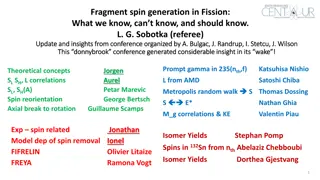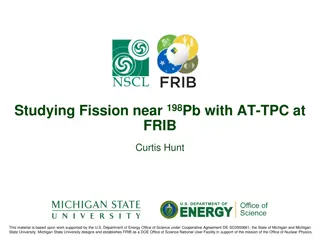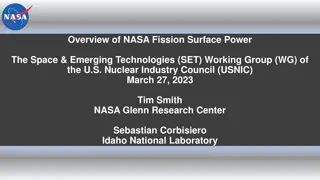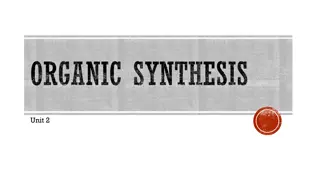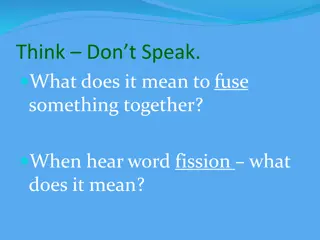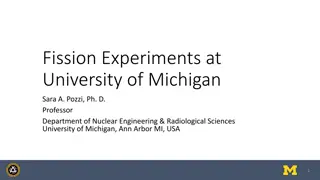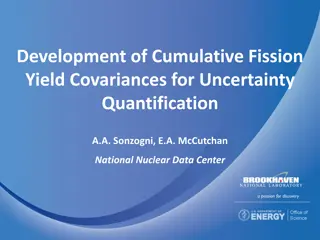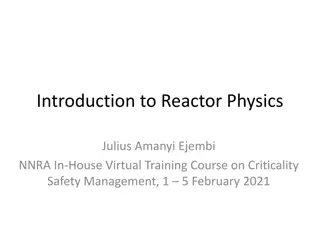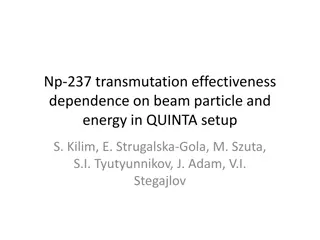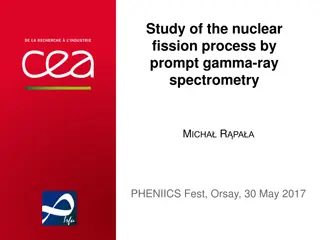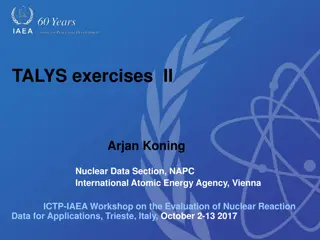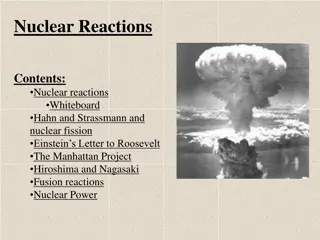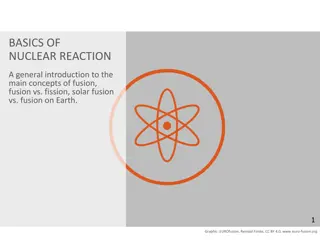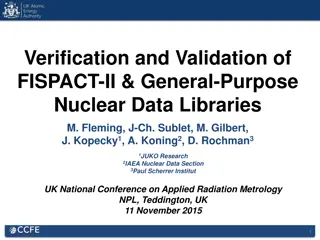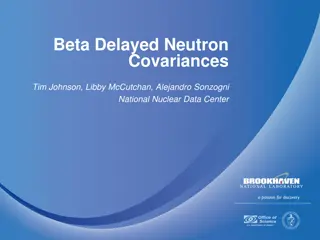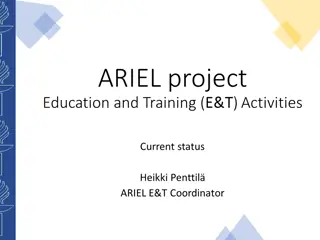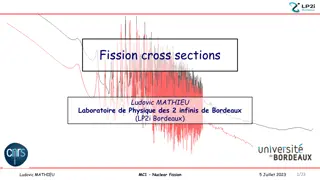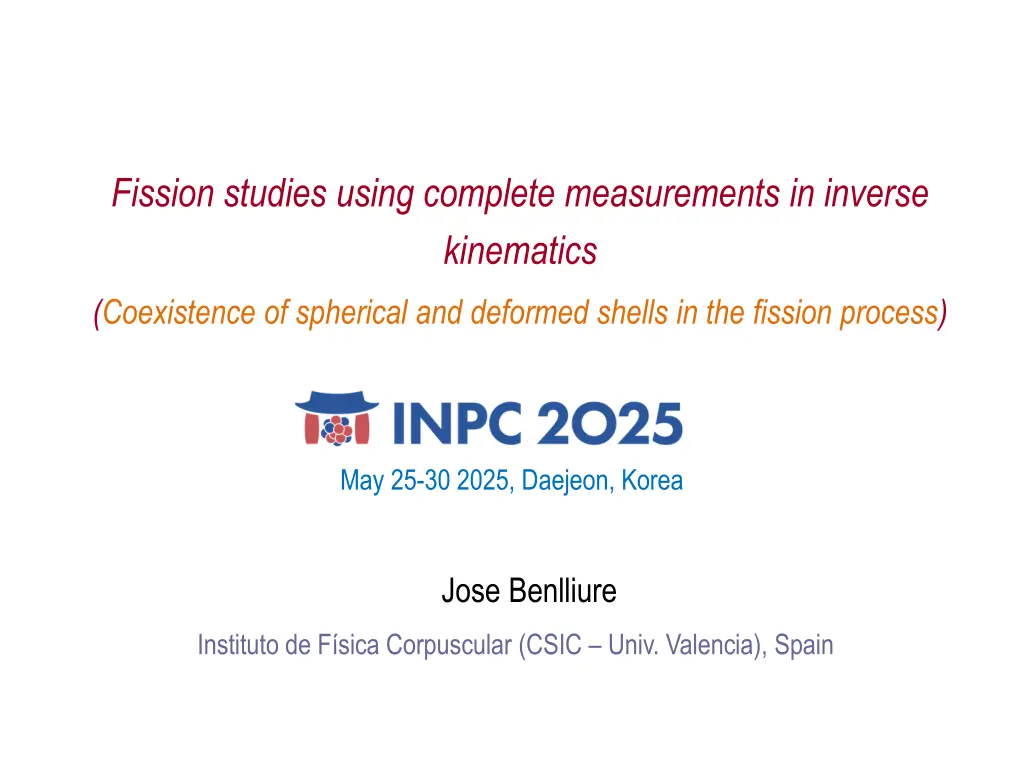
Fission Studies and Structural Effects in Potential Energy Surfaces
Explore fission studies in inverse kinematics focusing on the coexistence of spherical and deformed shells. Delve into dynamics, potential energy surfaces, fission barriers, and fragment yields. Uncover groundbreaking measurements of fission Z-yields and unexpected asymmetric fission events. Join the discussion on the role of shell effects in fission processes.
Uploaded on | 3 Views
Download Presentation

Please find below an Image/Link to download the presentation.
The content on the website is provided AS IS for your information and personal use only. It may not be sold, licensed, or shared on other websites without obtaining consent from the author. If you encounter any issues during the download, it is possible that the publisher has removed the file from their server.
You are allowed to download the files provided on this website for personal or commercial use, subject to the condition that they are used lawfully. All files are the property of their respective owners.
The content on the website is provided AS IS for your information and personal use only. It may not be sold, licensed, or shared on other websites without obtaining consent from the author.
E N D
Presentation Transcript
Fission studies using complete measurements in inverse kinematics (Coexistence of spherical and deformed shells in the fission process) May 25-30 2025, Daejeon, Korea Jose Benlliure Instituto de F sica Corpuscular (CSIC Univ. Valencia), Spain
Fission in a nutshell Dynamics Static properties: the potential energy surface Transient time Potential surface in deformation and mass asymmetry Role of shell effects at large deformation. Coupling between intrinsic and collective degrees of freedom Jos Benlliure 2 INPC2025, Daejeon, May 2025
The potential energy surface Observables and measurements Fission barriers Fission fragments yields (A or Z) Potential surface in deformation and mass asymmetry - Fission probabilities - A and Z distribution of fission fragments Fission modes role of shell effects. INPC2025, Daejeon, May 2025 Jos Benlliure 3
The potential energy surface Fission yields and structural effects in the potential energy surface Before 2000 Mostly mass distributions. A distribution A&Zlight distribution K.S. Krane Introductory Nuclear Physics, John Willey & sons, inc 1988 Asymmetric yields in actinides and narrow distributions around 258Fm explained by the dominant role of spherical shells N = 82 and Z = 50. 4 INPC2025, Daejeon, May 2025 Jos Benlliure
The potential energy surface Fission yields and structural effects in the potential energy surface Year 2000 First complete measurement of fission Z-yields in inverse kinematic experiments at GSI. K.-H. Schmidt et al. NPA (2000) A distribution A&Zlight distribution Z distribution The systematic measurement of charge distributions shows a dominant role of protons for ZH~52-55, in contradiction with previous interpretations. 5 INPC2025, Daejeon, May 2025 Jos Benlliure
The potential energy surface Fission yields and structural effects in the potential energy surface Year 2010 Unexpected asymmetric fission of 180Hg measured in - delayed fission at Isolde (2x90Zr50). A. Andreyev et al. PRL 105, 252502 (2010) L. Ghys et al., PRC 90, 044305 (2014) A distribution A&Zlight distribution Z distribution 180Hg First model calculations explained the asymmetric fission yields in 180Hg, even neglecting shell effects. P. Moller et al. PRC 91,044316 (2015) 6 INPC2025, Daejeon, May 2025 Jos Benlliure
The potential energy surface Fission yields and structural effects in the potential energy surface Year 2018 G. Scamps and C. Simenel PRC 105, 041602 (2019) Actinides Pre-actinides Octupole deformed proton shells around Z=52-56 explain the strong role of ZH~54 configurations in the Z-yields of actinides and together with N=88 will favor the formation of 144Ba. Octupole deformed neutron shells at N=52-56 also would explain the asymmetric fission of 180Hg into 100Ru56 + 80Kr44 7 INPC2025, Daejeon, May 2025 Jos Benlliure
The potential energy surface Fission yields and structural effects in the potential energy surface From 2018 to 2022 An intense experimental program was conducted to measure A-yields using fusion-fission and transfer reactions at GANIL, JAEA, ANU,... C. Schmitt et al. PRL 126, 132502 (2021) B.M. Swinton et al., PRC 102, 054611 (2020) E. Prasad et al., PLB 811, 135941 (2020) I. Tsekhanovich et al., PLB 790, 583 (2019) A. Bogachev et al. PRC 104, 024623 (2021) E.M. Kozulin et al., PRC 105, 014607 (2022) A distribution A&Zlight distribution Z distribution Mass yields measurements in pre-actinides confirmed the asymmetry around 180Hg due to the neutron shell gap NH~56 with . However, some works indicated the dominant role of ZL~36 over the neutron shells. Combined measurements of the A and Z fission yields are required to fully understand the role of the different shell gaps. INPC2025, Daejeon, May 2025 Jos Benlliure
Experimental breakthrough: inverse kinematics The kinematical boost of both fission fragments is the only methodology providing their complete identification. Observables: - Fission cross sections. - N and Z fission yields. - Total kinetic energies. - Neutrons and s in coincidence Fast heavy nucleus Nucleus at rest Compound nucleus in flight Reaction mechanisms: - Fusion (well defined CN, energy threshold, stable beams). - Transfer (well defined CN, energy scan, stable beams). - Coulex (unstable beams, no energy scan). - Quasi-free knock-out (unstable beams, energy scan). - Spallation (high energies, unknown CN). Jos Benlliure 9 INPC2025, Daejeon, May 2025
Experimental breakthrough: inverse kinematics The kinematical boost of both fission fragments is the only methodology providing their complete identification. VAMOS@GANIL Fusion/transfer: 2A & 1Z CUBE@ANU Fusion: 2A JAEA Fusion/transfer: 2A CORSET@Dubna Fusion: 2A BARC/VECC Fusion: 2A Fast heavy nucleus Nucleus at rest Compound nucleus in flight The fragmentation of 238U nuclei at relativistic energies makes it possible to investigate the fission of a huge number of heavy non stable nuclei. GSI: relativistic energies FRS: Coulex: 1A & 1Z SOFIA: Coulex: 2A & 2Z Jos Benlliure 9 INPC2025, Daejeon, May 2025 Schmidt: Coulex: 2Z
Complete measurements in inverse kinematics: R3B@FAIR Complete identification in A, Z of both fission fragments, TKE, gammas and neutrons Coulex and nucleon knockout Setup capabilities MUSIC, ToF-wall ( ToF~40 ps) and MWPCs ( x~200 m): fission fragments Z~0.37, A~0.55 - CALIFA and Si-tracker: protons and s, pos. resol. 75 m energy resolution. protons(gammas) 1% (5% @ 1 MeV), - Neuland: neutrons energy and multiplicity. - Jos Benlliure 10 INPC2025, Daejeon, May 2025
Complete measurements in inverse kinematics: R3B@FAIR Complete identification of both fission fragments For the first time both fission fragments were identified by their atomic and mass numbers. Their velocities were also determined with good accuracy. Z~0.4 A~0.6 E. Pellereau et al., Phys. Rev. C 95, 054603 (2017) J.L. Rodriguez et al., Phys. Rev. C 91, 064616 (2015) Jos Benlliure 11 INPC2025, Daejeon, May 2025
Complete measurements in inverse kinematics: R3B@FAIR Fission yields and structural effects in the potential energy surface Year 2025 (SOFIA@R3B - Coulex) A distribution A&Zlight distribution Z distribution A&Z distribution ZH~54 The SOFIA campaign in 2021 enabled the measured yields of fissioning nuclei to increase by 40%. These systematic measurements definitively confirm the role of the deformed shell at ZL=36. 12 ZL~36 INPC2025, Daejeon, May 2025 Jos Benlliure
Complete measurements in inverse kinematics: R3B@FAIR Fission yields and structural effects in the potential energy surface The investigation of the potential energy surface in fission during the last 20 years has focused on the role of deformed closed shells while the initial explanation of the asymmetric yields in fission was originally attributed to the spherical closed shells. Year 2000 Year 2025 K.S. Krane Introductory Nuclear Physics, John Willey & sons, inc 1988 P. Morfouace et al., Nature 641, 339 (2025) ZH~54 ZL~36 Do spherical shells still have a role to play in fission? 13 INPC2025, Daejeon, May 2025 Jos Benlliure
Complete measurements in inverse kinematics: R3B@FAIR QFS-induced fission of 238U @ 540A MeV Emitted proton (p,2p) fission Quasi-free scattering on protons provides the excitation energy of the fissioning system from the reconstruction of the missing energy measuring the momenta of the two outgoing protons. Fast heavy nucleus Scattered proton Emitted neutron (p,pn) fission Fast heavy nucleus Scattered proton (p,p ) fission Quasi-free scattering on neutrons or ineleastic proton scattering can also provide some information on the excitation energy from the masses of the two final fragments . Fast heavy nucleus 14 INPC2025, Daejeon, May 2025 Jos Benlliure Scattered proton
QFS-induced fission of 238U @ 540A MeV Excitation energy from missing mass Z1 + Z2 = 91 E* Missing mass was obtained for QFS 238U(p,2p). A1+A2 of the final fission fragments shows a good sensitivity to the excitation. Gabriel Garc a PhD, USC Jos Benlliure 15 INPC2025, Daejeon, May 2025
Evolution of the fission yields with the excitation energy Damping of shell effects with the excitation energy A1+A2=235 E*~8 MeV A1+A2=233 E*~17 MeV A1+A2=231 E*~33 MeV A1+A2=229 E*~50 MeV A1+A2=227 E*~65 MeV A1+A2=225 E*~80 MeV A1+A2=223 E*~100 MeV A1+A2=221 E*~120 MeV Gabriel Garc a PhD, USC Jos Benlliure 16 INPC2025, Daejeon, May 2025
Evolution of the fission yields with the excitation energy Evolution of fission modes in Z-yields with the excitation energy Ant a Gra a PhD, USC Jos Benlliure 17 INPC2025, Daejeon, May 2025
Evolution of the fission yields with the excitation energy Evolution of fission modes in N-yields with the excitation energy Ant a Gra a PhD, USC Jos Benlliure 18 INPC2025, Daejeon, May 2025
Fission yields and shell effects E* Fission yields are dominated by deformed shells at Z~54, N~84, and Z~56, N~89. The dumping with energy of both proton (Z=52-56), and neutron (N=82-86) shells seems to be similar Ant a Gra a PhD, USC Jos Benlliure 19 INPC2025, Daejeon, May 2025
Fission yields and shell effects Evolution of the neutron excess with the excitation energy in 238U(p,p )fission Z1 + Z2 = 92 132Sn E* 238U 106Mo Polarization (neutron-excess) seems to be driven by the closed shell Z=50. The evolution of the neutron excess with energy reflects the energy sharing between the fragments. Ant a Gra a PhD, USC Jos Benlliure 20 INPC2025, Daejeon, May 2025
Fission yields and shell effects Two-dimensional analysis of the fission yields N/Z=1,57 N/Z=1,61 N/Z=1,64 Z=50, N=82 Z~52, N~84 Z~56, N~88 The one-dimensional projection of the fission yields (Z or N) prevents to observe the spherical shell. A two-dimensional analysis or a N/Z projection shows the co-existence of spherical and deformed shells. Jos Benlliure 21 INPC2025, Daejeon, May 2025
Summary Important experimental and theoretical progress has been achieved during the last years on the investigation of shell effects in the potential governing the fission process . - The major role of octupole deformed proton shells has been shown (Z~36 and Z~52-56). - The dominant role of proton or neutron shells is still under debate. Inverse kinematics represents a real breakthrough in the experimental investigation of fission. - The SOFIA/R3B experiment has allowed for the first time the complete identification in atomic and mass number of both fission fragments. -A complete mapping of the island of asymmetric fission in pre-actinides has been obtained. Quasi-free proton scattering induced fission on 238U at R3B has opened access to the excitation energy of the fissioning nuclei providing information on the damping of shell effects. The N and Z fission yields (1D) can be described in terms of deformed shells Z~52, N~84 and Z~56, N~88. The neutron excess of the fission fragments shows, however, a clear role of the spherical shells at Z=50 and N=82. Only a 2D analysis (A,Z) of the fission shows the co-existence of spherical and deformed shells. Jos Benlliure 22 INPC2025, Daejeon, May 2025
Acknowledgements PhD students at USC: Ant a Gra a and Gabriel Garc a Jos Benlliure 23 INPC2025, Daejeon, May 2025
QFS-induced fission of 238U @ 540A MeV Identification of the fission fragments Z=36 Resolution in mass number: A/A = 0,9% 0.8 (FWHM) A=88 1.2 (FWHM) A = 132 Resolution in atomic number: Z = 0.38 (FWHM) Typical competing experiments: A ~ 3-4 mass units Ant a Gra a PhD, USC Jos Benlliure 25 R3B week, November 2024

